In today's dynamic business landscape, carve-out transactions have become increasingly common as companies seek to streamline operations, divest non-core assets, or pursue strategic realignment. However, one of the most complex aspects of carve-outs is integrating technology systems and infrastructure. This process involves disentangling IT assets from the parent company's systems while ensuring the seamless operation of critical business processes in the carved-out entity. Here, we explore the key technology integration challenges in carve-out transactions and strategies for overcoming them.
Legacy System Compatibility
One of the foremost challenges in technology integration during a carve-out is ensuring compatibility between the legacy systems of the carved-out entity and those of the parent company. Often, these systems have evolved independently, leading to differences in architecture, data formats, and software versions. Integrating disparate systems while minimizing disruption to business operations requires careful planning, thorough analysis, and robust compatibility testing. Companies may need to invest in middleware solutions, data transformation tools, or custom integration interfaces to facilitate seamless communication between legacy systems.
Data Migration and Consolidation
Data migration is another critical aspect of technology integration in carve-out transactions. The carved-out entity may have its own databases, repositories, and data structures, which must be migrated to the parent company's systems or new infrastructure. Data cleansing, transformation, and consolidation are essential to ensure data integrity, accuracy, and accessibility post-transaction. Moreover, data privacy and security considerations add another layer of complexity, particularly when dealing with sensitive or regulated data. Implementing robust data migration strategies and leveraging automation tools can help streamline the migration process and minimize the risk of data loss or corruption.
IT Infrastructure Rationalization
In many carve-out transactions, the carved-out entity inherits a portion of the parent company's IT infrastructure, including hardware, networks, and data centers. Rationalizing IT infrastructure involves assessing the existing infrastructure assets, identifying redundancies or inefficiencies, and optimizing resource utilization to align with the needs of the carved-out entity. This may involve consolidating data centers, migrating to cloud-based solutions, or standardizing hardware and software platforms. However, such initiatives require careful planning and coordination to avoid disruptions to ongoing operations and ensure the scalability and resilience of the IT environment.
Change Management and Training
Technology integration in carve-out transactions inevitably impacts employees across the organization, requiring them to adapt to new systems, processes, and ways of working. Effective change management and training programs are essential to support employees through this transition and minimize resistance or productivity loss. Providing comprehensive training on new systems and processes, offering ongoing support and guidance, and fostering a culture of collaboration and learning can help employees navigate the changes with confidence and embrace the opportunities presented by the carve-out.
Conclusion
Technology integration challenges in carve-out transactions are multifaceted and require careful planning, coordination, and execution to ensure a successful outcome. By addressing issues related to legacy system compatibility, data migration, IT infrastructure rationalization, and change management, companies can overcome these challenges and unlock the full potential of carve-out transactions. Moreover, by leveraging technology as an enabler of business transformation, organizations can position themselves for long-term growth, innovation, and competitive advantage in the evolving marketplace.





Comments